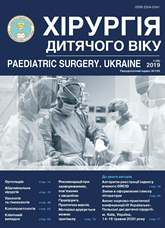Peculiarities of clinical-radiological course of different forms of fibrous dysplasia
DOI:
https://doi.org/10.15574/PS.2019.65.10Keywords:
fibrous dysplasia, pathological bone fractures, bone deformity, diagnosis, clinical manifestations, radiological symptomsAbstract
The aim of the study: to improve the diagnosis of forms of fibrous dysplasia by investigating clinical and radiological features, depending on the disease form, age and sex of the patient.Materials and methods. The research was conducted by analyzing results of examination and treatment of 80 patients with different forms of fibrous dysplasia at Kyiv Institute of Traumatology and Orthopedics by NAMS of Ukraine from 2000 to 2019. The diagnosis was made on the basis of studying features of the medical history of the disease, its clinical course and radiological examination method. There were 56 patients with monoosal disorder, 14 with polyosal, and 10 with Albright syndrome. Clinical-radiological method of the research was used to clarify the diagnosis of the disease and to study features of the disease. The radiological examination was performed on the Multix UP in the department of functional diagnostics «ITO NAMSU» according to the standard technique in direct posterior and lateral projections with capture of adjacent joints. Localization, volume of lesion and condition of cortical layer at pathological dysplastic process of long bones of lower extremities were evaluated.
Results. The article specifies clinical-radiological features revealed in various forms of fibrous dysplasia and shows that pathological fractures of the long bones and their deformation depend on the form of the disease, age and sex of patients. The incidence of pathological fractures of long bones of lower extremities was determined depending on the localization, form of the disease and sex of patients with different forms of fibrous dysplasia: femur – 72.3% (proximal part – 76.7%); tibia bones – 27.3% (diaphyseal part – 78.3%); it was found that the number of fractures was significantly greater (49.4%) with the monoosal form of fibrous dysplasia than with the polyosal form (30.1%, p<0.05) and Albright syndrome (20.5%, p<0,5); in males with monoosal form and Albright syndrome, the number of fractures was significantly greater (p<0.05) than in females.
Conclusions. Features of the course of clinical and radiological manifestations depending on the form of the disease, age and sex of the patient have been covered in the article, which will allow reducing and eliminating diagnostic errors related to this pathology and create a basis for improvement of the system of orthopedic treatment of this nosology.
The research was conducted in accordance with principles of the Declaration of Helsinki. The research protocol was approved by institution’s Local Ethics Committee. Informed consent was obtained from parents of children (or their guardians) for the research.
References
Dolnitsky OB. (2009). Congenital malformations. Fundamentals of diagnosis and treatment. Kyiv: Business Polygraph: 516–523.
Zubairov TF. (2009). Diagnosis and surgical treatment of fibrous osteodysplasia: dissertation. St. Petersburg: 161.
Kosinska NA. (1966). Disorders of the development of the bone and joint apparatus. Leningrad: Medicine: 357.
Sadovenko EG. (1992). Fibrous dysplasia (diagnostics, therapeutic tactics): dissertation. Kyiv: 145.
Breck LW. (1972). Treatment of fibrous dysplasia of bone by total femoral plating and hip nailing. Clin Orthop. 82: 82-91. https://doi.org/10.2106/JBJS.O.00547; PMid:26842411 PMCid:PMC4732545
DiCaprio MR, Enneking WF. (2005). Fibrous dysplasia. Pathophysiology, evaluation, and treatment. J Bone Joint Surg.87-A(8): 1848-1864. https://doi.org/10.2106/00004623-200508000-00028
Jung ST, Chung JY, Seo HY, Bae BH, Lim KY. (2006). Multiple osteotomies and intramedullary nailing with neck cross-pinning for shepherd’s crook deformity in polyostotic fibrous dysplasia: 7 femurs with a minimum of 2 years follow-up. Acta Orthop. 77(3): 469-73. https://doi.org/10.1080/17453670610046415; PMid:16819687
Kushare V, Colo D, Bakhshi H, Dormans JP. (2014). Fibrous dysplasia of the proximal femur: surgical management options and outcome. J Child Orthop.8: 505-511. https://doi.org/10.1007/s11832-014-0625-9; PMid:25409925 PMCid:PMC4252268
Lichtenstein L. (1938). Polyostotic fibrous dysplasia. Arch Surg.36: 874-98. https://doi.org/10.1001/archsurg.1938.01190230153012
Lichtenstein L, Jaffe H. (1942). Fibrous dysplasia of bone. Arch Path.33: 777-816.
Shah ZK, Peh WC, Koh WL, Shek TW. (2005). Magnetic resonance imaging appearances of fibrous dysplasia. Br. J Radiol.78(936): 1104. https://doi.org/10.1259/bjr/73852511; PMid:16352586
Stephenson RB, London MD, Hankin FM, Kaufer H. (1987). Fibrous dysplasia. An analysis of options for treatment. J Bone Joint Surg Am. 69: 400-409. https://doi.org/10.2106/00004623-198769030-00012
Thomsen MD, Rejnmark L. (2014). Clinical and radiological observations in a case series of 26 patients with fibrous dysplasia. Calcif Tissue Int.94: 384-395https://doi.org/10.1007/s00223-013-9829-0; PMid:24390518
Yao L, Eckardt JJ, Seeger LL. (1994). Fibrous dysplasia associated with cortical bony destruction: CT and MR findings. J Comput Assist Tomogr.18: 91-94. https://doi.org/10.1097/00004728-199401000-00019; PMid:8282892
Downloads
Issue
Section
License
The policy of the Journal “PAEDIATRIC SURGERY. UKRAINE” is compatible with the vast majority of funders' of open access and self-archiving policies. The journal provides immediate open access route being convinced that everyone – not only scientists - can benefit from research results, and publishes articles exclusively under open access distribution, with a Creative Commons Attribution-Noncommercial 4.0 international license(СС BY-NC).
Authors transfer the copyright to the Journal “PAEDIATRIC SURGERY.UKRAINE” when the manuscript is accepted for publication. Authors declare that this manuscript has not been published nor is under simultaneous consideration for publication elsewhere. After publication, the articles become freely available on-line to the public.
Readers have the right to use, distribute, and reproduce articles in any medium, provided the articles and the journal are properly cited.
The use of published materials for commercial purposes is strongly prohibited.

